- Author Jason Gerald [email protected].
- Public 2023-12-16 10:50.
- Last modified 2025-01-23 12:04.
The pop-up element adds an interesting new aspect to any book (hopefully, of course, the textbook has a pop-up element in it). If you're looking for a craft you'd like to make for a little kid you know (or anyone!), you can make your own simple pop-up book. All you need is a story, some free time, and some simple materials.
Step
Method 1 of 3: Planning the Book
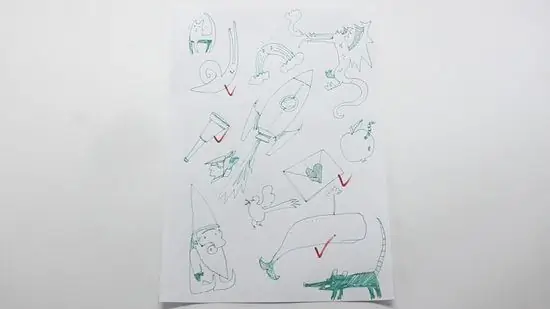
Step 1. Choose a topic of interest
If you are planning to give the book to a child, the subject of your pop-up book should be child-friendly. But don't adults love a good 3D story?
- The stories for your book can be fiction or non-fiction. If you choose fiction, you can pick up a short but classic folk tale or you can write your own story. If you choose non-fiction, look for a subject your child might be interested in, such as space, dinosaurs, or animals.
- You don't have to think of it as a proper "book". This can double as a letter, proposal, or additional idea for a gift.
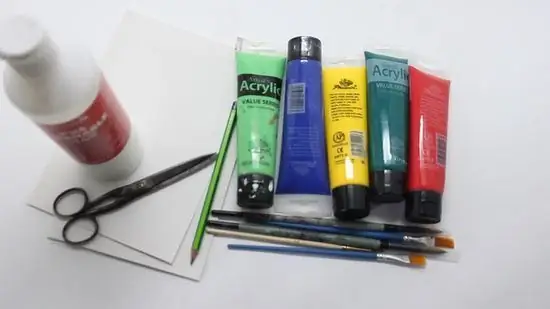
Step 2. Keep things in it simple
Limit the number of pop-up elements you use to prevent the pages from looking cluttered or becoming too weak to hold. The fewer cuts you make on the pages of your book, the more durable your pages will be.
Feel free to add other craft elements, such as glitter or patchwork to make it interesting. However, if you use it too much, it can make your book pages look crowded and make them unnecessarily heavy
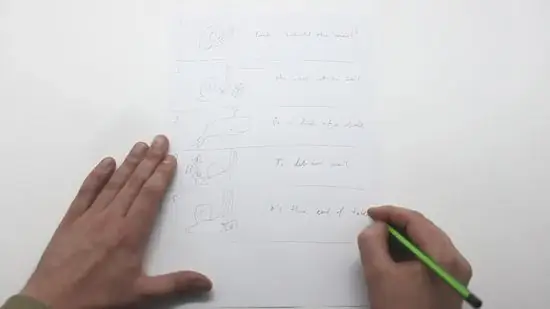
Step 3. Plan the story
Make a storyboard. Write the story or script on notepad, breaking it into separate paragraphs or lines as you consider the needs of the next page. Make a rough concept sketch of the illustration you want to use for each page.
Before you start creating the book, it is very important that you know how many pages you will need and how many pictures you will need, and where you will place the pictures
Method 2 of 3: Compiling Your Book
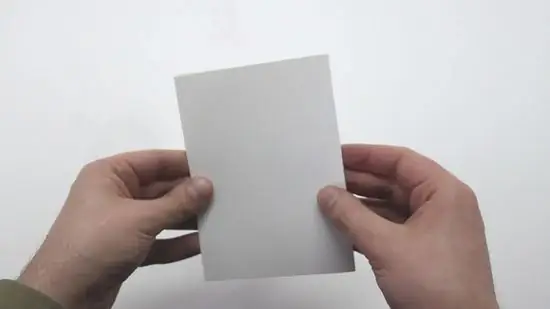
Step 1. Fold a sturdy sheet of paper into two equal parts
You can use a sheet of construction/craft paper that is 23x30 cm, but you can also use stiff paper/cardboard, thin poster paper, or decorative/patch paper for scrapbooks of any size.
This paper should be thicker than regular printing paper. Fold the paper in half horizontally to make a book cover

Step 2. Cut the two halves horizontally and parallel to the center of the paper to create a gap
The gap should be about 5 cm long and about 2.5 cm wide. This gap will be the pop-up holder.
Open your paper. Position it vertically so that the high part looks longer than the wide part. Use your finger or a pencil or thin pen to gently lift the brace forward
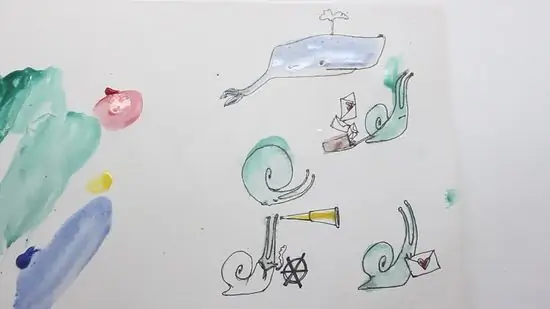
Step 3. Create your illustration
You can draw and color the illustrations on construction paper or other stiff paper/cardboard, or you can cut out pictures from photos, magazines, or recycled picture books and paste them onto sturdier cardboard.
- Make sure the pictures you create or use are appropriate to the page size of your book. And also make sure you have all the characters or images you need for your entire book, not just one page.
-
Set aside an empty space at the bottom of the page for text. If you plan to ask a child to write a story, you may need to use a ruler to draw lines to make it easier for them to write. You can also paste some of the lined paper you have in your notebook on the blank.
If you plan to write the text yourself, however, you can leave the section blank or print the text from your computer and then paste it onto the page
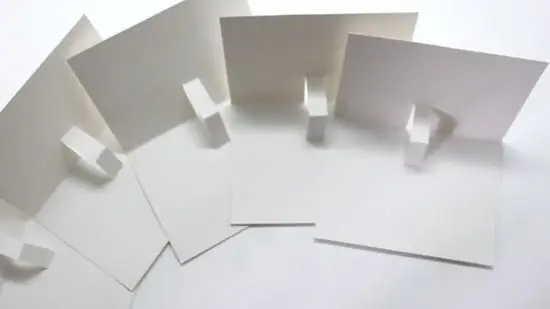
Step 4. Create the necessary pages
Use the same folding and cutting technique to create as many pages as you need to bring the story to a close.
Review your story. Make sure you have accurate illustrations and images with text. Also make sure you create enough pages for your story
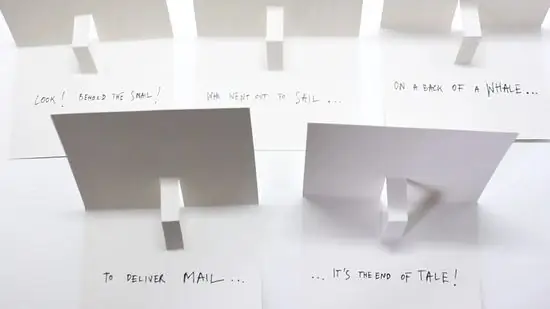
Step 5. Write down the reading text
Go to each page and write or paste text at the bottom of each page.
If your text is taking up more space, stick a piece of paper that folds up and opens when the book is opened. Then paste your text onto the paper. The problem is finished
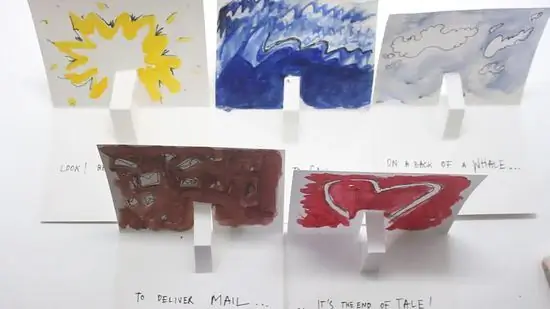
Step 6. Decorate the background of each page
Sketch the background using a pencil before coloring it with the coloring method of your choice. Leave the pop-up holder blank/uncolored.
If you have a good eraser, go back and erase your pencil lines for refinement
Method 3 of 3: Make It Jump Out
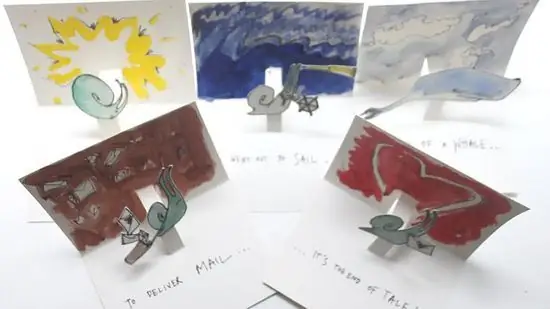
Step 1. Cut and paste your images on the pop-up holders
Cut out the pictures and illustrations you make. Glue the back of each image and attach it to the appropriate holder. However, don't let the image get stuck to the background of the page. The image won't jump out!
If you're using liquid glue, make sure you don't use too much. Apply glue to the holder and not to the drawing; that way you won't risk putting glue up or down the holder
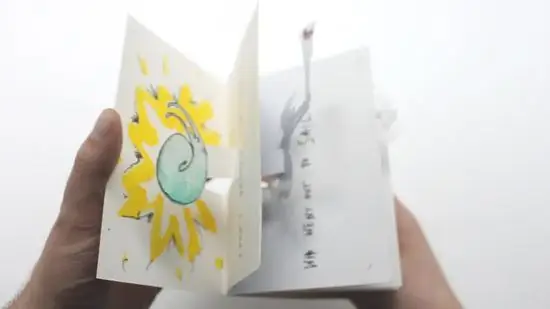
Step 2. Pinch your pages together
The pages must be pasted on the back to the back of the other pages. The top half of the outer side of the second page will be pasted on the bottom half of the outer side of the first page. The top half of the outer side of the third page will be pasted on the bottom half of the outer side of the second page. Continue this pattern until all the pages are pasted into other pages.
Don't stick the pop-up holders together, as this will prevent them from pop-ups (jumping out)
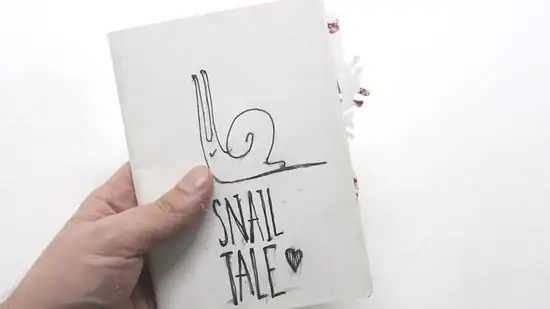
Step 3. Make the outer cover of the book
Fold a sturdy piece of paper that is slightly larger than the entire book. Paste the folded paper on the book, decorate the front and back of the outer cover, and then glue the inside of the cover, namely the front with the first page of the book and the back with the last page of the book.
- This, of course, is optional. If you are using it as a story-like letter or for any other purpose, a book cover will be necessary.
- Enjoy! Once the glue is completely dry, the book is ready to be read.
Tips
You can also create more than one pop-up image per page. Cut a few pairs of slits along the crease, evenly spaced between them, until you've created the amount of hold you need for your illustration
Things You'll Need
- Stiff Paper
- Scissors
- Pencil and pen
- Colored pencils, crayons, paints or markers
- Glue
- Ruler






